#Land mines
Text

Instagram: armiehammer
HE’S BACK! 💙💪🔨💥
187 notes
·
View notes
Text



Elizabeth Debicki as Princess Diana in The Crown final season
#the crown netflix#cinemapix#tv and film#elizabeth debicki#the crown season 6#the crown spoilers#actress#princess diana#humanitarian#land mines#the crown final season#thecrownedit#elizabethdebickiedit#thecrownnet#tvedit#netflixedit#streaming#what to watch#coming doon
91 notes
·
View notes
Text

#meme#memes#shitpost#shitposting#humor#funny#lol#satire#funny memes#dark humor#funny meme#roomba#land mines#sarcasm#irony#joke#parody
75 notes
·
View notes
Text










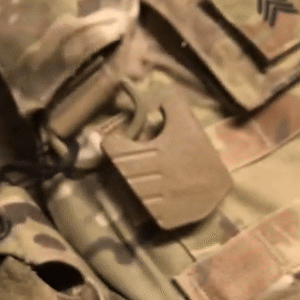





Anonymous asked: i need 500 billion pav themed stims.pav my beloved pav my beloathed
Fear and hunger..
x x x
x x x
x x x
x x x
x x x
Banner
Though this isn't my footage, I took the time to make all these gifs*. See my terms of use BEFORE you reupload!
* except for the one directly to the right of Pav!
#[this is as close to 5 billion i was able to get without casting Dashboard Slow 😔]#bullet#camouflage#candy cane#cleaning#f&h#f&h termina#f&h2#fnh#fear and hunger#fear and hunger termina#funger#funger termina#gun#hot chocolate#ice cream#land mines#luger#military#pav#pavel yudin#peppermint#pistol#stim#sugar cookies#sword#content: stimboard#content: upload#item: weapon#cw: food
18 notes
·
View notes
Text
#OTD in 1923 – Nine Republican prisoners are taken from Ballymullen Barracks in Tralee to Ballyseedy Cross, ostensibly to clear a mined road.
Kerry had seen more violence in the guerrilla phase of the Civil war than almost anywhere else in Ireland. By March 1923, sixty-eight Free State soldiers had already been killed in Kerry and 157 wounded. Eighty-five would die there by the end of the war.
The day after Five Free State soldiers were killed by a booby trap bomb while searching a republican dug out at the village of Knocknagoshel,…

View On WordPress
#(Yann Goulet#Ballyseedy Massacre#Ballyseedy Monument#Co. Kerry#Free State Soldiers#Guerilla warfare#Ireland#Irish Civil War#Irish History#Knocknagashel#Land mines#Paddy Daly#Republicans#Sculpter)#Tralee
9 notes
·
View notes
Text

#dank memes#funny post#meme#dank#silly#funny#funny pics#funny pictures#dankest memes#humor#memes#comedy#dark humor#politics#news#land mines
47 notes
·
View notes
Photo

67 notes
·
View notes
Text
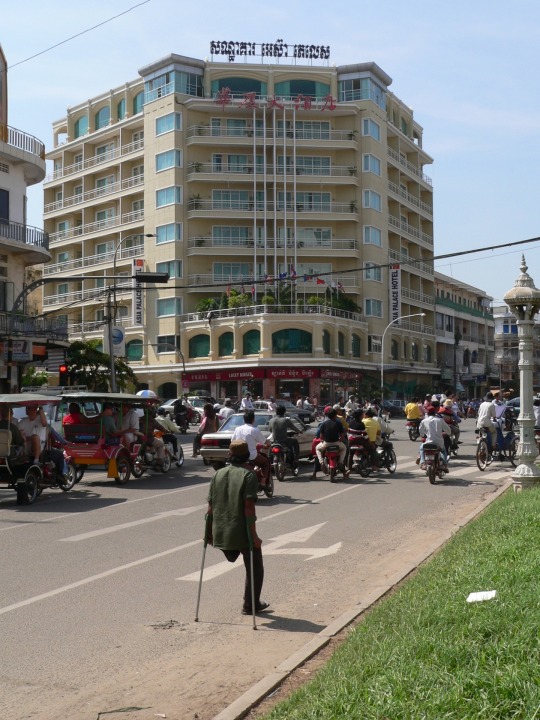
Phnom Penh, 2005
5 notes
·
View notes
Text
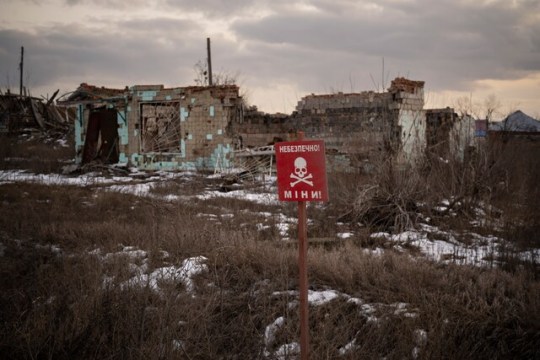
A sign warns of mines in the village of Kamyanka, on the outskirts of Izium, Ukraine, on Feb. 19. (Vadim Ghirda/AP)
There is now a huge amount of ordnance contamination in Ukraine and I think this problem is going to continue for a very long time and will have many chaotic negative consequences. Ordnance contamination refers to the presence of unexploded ordnance including mines, shells, rockets, and bombs in current and former war zones. Once hostilities have ceased, these objects, also known as ERW (Explosive Remnants of War) retain their explosive qualities and continue to injure and kill people, and can also leach toxic substances such as lead, mercury, and depleted uranium into the environment.
Anti-personnel mines are particularly deadly. There are some newer types of mine (both anti-personnel and anti-vehicle) that are designed to eventually self-detonate, which would ideally reduce risk to civilians post-war, but these self-detonation systems have significant failure rates, and in cases where the self-detonation system fails, the mine remains active indefinitely. No matter what model of mine is deployed, it always results in ordnance contamination and poses grave danger to civilians.
In 2020, there were 7,073 injuries and deaths due to mines and ERW worldwide. 80% of those casualties were civilians.
But 2020 has passed, and as the Russo-Ukranian war drags on, more and more mines and ERW are being scattered across conflict zones by both Russian and Ukrainian forces.
Articles under the cut.
Here is an article about the recently alleged illegal use of anti-personnel mines by Ukrainian forces:
Evidence mounts for use of banned mines by Ukrainian forces, rights group says
By Eve Sampson and Samuel Granados
June 30, 2023 at 12:00 a.m. EDT
Ukrainian forces appear to have used rockets to scatter stacks of internationally banned, hand-size antipersonnel land mines over Russian-occupied areas in eastern Ukraine, according to evidence collected by Human Rights Watch.
A report released overnight adds to previous evidence collected by the New York-based rights group suggesting that Ukrainian forces scattered thousands of antipersonnel mines last year, injuring civilians, in violation of the 1997 Mine Ban Treaty, to which Ukraine is a signatory. Russia, which has not signed the treaty, has used antipersonnel mines far more extensively, rights groups say.
The bodyweight-triggered mines in question are considered particularly pernicious and violate international laws of war because they harm soldiers and civilians indiscriminately. Their small size and innocuous appearance can lead to children or other civilians handling them unknowingly.
The rights group examined photographs of the remains of rockets found in eastern Ukraine that are used exclusively to scatter PFM-1S antipersonnel mines. Handwritten messages on the remains could be traced back to Ukrainian organizations that offered to have “death wishes” inscribed on various munitions to raise funds for the war effort.
Russian forces have made use of at least 13 different types of banned antipersonnel mines, as well as victim-activated booby traps, in the invasion of Ukraine, Human Rights Watch found in previous reports. But Ukraine has expressly committed not to use them, despite evidence suggesting the contrary.
“These antipersonnel mines have had immediate and devastating consequences for civilians in and around Izium, including by tearing off limbs of residents as they go about their daily lives,” said Ida Sawyer, the director of Human Rights Watch’s crisis and conflict division.
Known as butterfly or petal mines for their shape, small size and light weight, PFM mines are typically green or brown, and one wing is filled with explosives meant to detonate when enough pressure, between 11-55lbs, is applied.
Though some types of PFMs can be emplaced by hand, PFM-1S variant must be deployed using a mine-laying system from a mortar, aircraft or rocket such as the Uragan 9M27K3 mine-laying rocket identified in the report.
Such rockets can carry 312 mines in stacks of “cassettes” that disperse after the rocket is fired.
PFM-1S mines, which can float down to the ground without detonating, are equipped with a mechanism that is designed to self-destruct between 1-40 hours after deployment.
When that mechanism fails, which it often does, the mines threaten civilians by remaining undetonated on the ground indefinitely.
The 1997 Mine Ban Treaty, to which the United States, like Russia, is not a party, requires countries to abstain from using antipersonnel mines and get rid of any stores they may have, a process that can be costly.
Russia’s rejection of the treaty does not exempt it from accountability, Sawyer said, as any use of “inherently indiscriminate weapons” violates international law.
Though Ukraine ratified the treaty in 2005 and officials reported the destruction of millions of antipersonnel mines, in 2021 the country reportedly still possessed more than 3 million.
Any use of mines contributes to an arduous process for returning Ukraine’s land to civilian use. Demining is a slow, costly enterprise that experts say could take as many as hundreds of years.
Since Ukraine regained control of the territory around Izyum, Sawyer said, a new round of mine injuries have been reported. “Because of the nature of these mines,” Sawyer said, “civilians will likely suffer for many years to come.”
Here is an article about Ukraine’s current prognosis with regards to mines and ERW:
Ukraine is now the most mined country. It will take decades to make safe.
By Eve Sampson and Samuel Granados
July 22, 2023 at 3:00 a.m. EDT
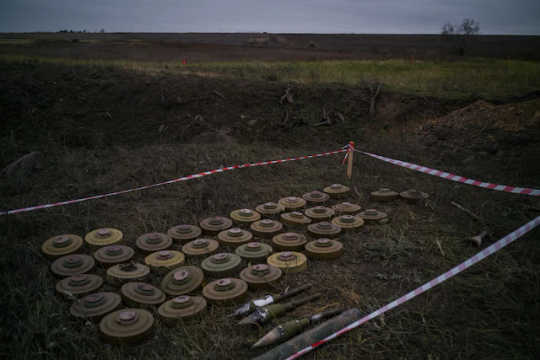
Mines and unexploded rockets next to a destroyed bridge on the way to Kherson, Ukraine, in November. (Wojciech Grzedzinski for The Washington Post )
In a year and a half of conflict, land mines — along with unexploded bombs, artillery shells and other deadly byproducts of war — have contaminated a swath of Ukraine roughly the size of Florida or Uruguay. It has become the world’s most mined country.
The transformation of Ukraine’s heartland into patches of wasteland riddled with danger is a long-term calamity on a scale that ordnance experts say has rarely been seen, and that could take hundreds of years and billions of dollars to undo.
Efforts to clear the hazards, known as unexploded ordnance, along with those to measure the full extent of the problem, can only proceed so far given that the conflict is still underway. But data collected by Ukraine’s government and independent humanitarian mine clearance groups tells a stark story.
Ordnance contamination
HALO Trust used open-source information to track more than 2,300 incidents involving ordnance and mines in Ukraine from the start of Russia’s invasion on Feb. 24, 2022, up to July 11, 2023.
“The sheer quantity of ordnance in Ukraine is just unprecedented in the last 30 years. There’s nothing like it,” said Greg Crowther, the director of programs for the Mines Advisory Group, a British charity that works to clear mines and unexploded ordnance internationally.
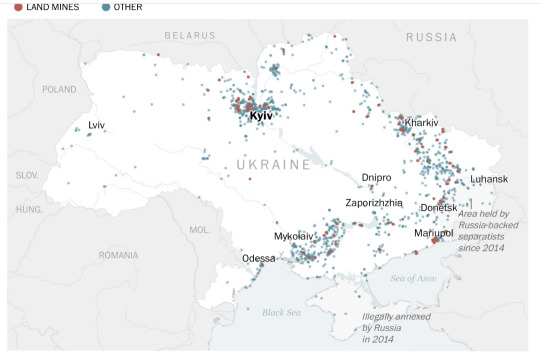
Staggering scale
About 30 percent of Ukraine, more than 67,000 square miles, has been exposed to severe conflict and will require time-consuming, expensive and dangerous clearance operations, according to a recent report by GLOBSEC, a think tank based in Slovakia.
Though the ongoing combat renders precise surveys impossible, the scale and concentration of ordnance makes Ukraine’s contamination greater than that of other heavily mined countries such as Afghanistan and Syria.
HALO Trust, an international nonprofit that clears land mines, has tracked, using open-source information, more than 2,300 incidents in Ukraine in which ordnance requiring clearance was discovered. Though events are greatly underreported and the data does not include the results of on-the-ground surveys by HALO Trust or other organizations, it gives a harrowing outline of the problem.
This week’s deployment by Ukrainian forces of U.S.-made cluster munitions, which are known to scatter duds that fail to explode, can only add to the danger.
Human cost
The explosives have already taken a heavy toll. Between the start of Russia’s full-scale invasion in February 2022 and July 2023, the United Nations has recorded 298 civilian deaths from explosive remnants of war, 22 of them children, and 632 civilian injuries.

Hidden killers
Both sides use mines. Russia heavily mined its front lines in anticipation of Ukraine’s ongoing counteroffensive, and has made far more extensive use of widely banned antipersonnel mines.
Small, deadly antipersonnel mines, triggered by the weight of the human body, cannot discriminate between combatants and noncombatants.
Russian forces have used at least 13 types of antipersonnel mines, as well as victim-activated booby traps, Human Rights Watch investigations found. Evidence suggests Ukraine has also used at least one type of antipersonnel mine, a rocket-delivered PFM blast mine, around the Ukrainian city of Izyum in summer 2022.
Antitank mines, which usually require immense weight to detonate, are not internationally banned, though any explosive device that could be detonated unintentionally by a civilian can be considered an antipersonnel mine under the 1997 Mine Ban Treaty, to which Ukraine, but not Russia or the United States, is a party.
Both Russian and Ukrainian forces have used anti-vehicle mines.
The United States included two types of mines in its aid packages to Ukraine: the Remote Anti-Armor Mine System, which uses 155-milimeter artillery rounds to create temporary minefields programmed to self-destruct, and M21 antitank mines, which require hundreds of pounds of force to detonate but do not self-destruct, leading to concerns about later removal.
Mines are not the only type of explosive that pose a threat. Mortars, bombs, artillery shells, cluster munitions and others also become hazards if they do not explode when deployed.
Undoing the damage
Russia’s heavily mined defenses, built up over months of stalemate along the front lines, are slowing down the Ukrainian counteroffensive that began last month, damaging Western-supplied battle tanks and infantry fighting vehicles.
Though specialized mine-clearing vehicles are in use, front-line mines are so concentrated that specialized soldiers, called sappers, have had to resort to clearing paths by hand.
Humanitarian clearance operations, which return denied land to local populations after conflict, are extremely slow, tedious and expensive. They are underway across parts of Ukraine, including around Kyiv, the capital, and other areas West of the front lines, where the battle has receded.
Ukraine’s contaminated territory is so massive that some experts estimate humanitarian clearance would take the approximately 500 demining teams in current operation 757 years to complete.
Demining is not just slow, it’s also expensive. The World Bank estimates that demining Ukraine, which costs between $2 and $8 per square meter, will cost $37.4 billion over the next 10 years.
The United States has committed more than $95 million to Ukraine’s demining, according to a 2023 State Department report.
How Ukraine compares
Mines as a dark legacy of conflict all over the world, from Cambodia to Kosovo, hint at the challenges Ukraine could face as it rebuilds.
Cambodia, riddled with millions of land mines after decades of conflict, has been subject to ongoing clearance operations for 30 years. Crowther estimates there at least five years of work remains. Tens of thousands of people have been maimed by Cambodia’s mines.
Kosovo saw armed conflict in 1998 and 1999. “Kosovo was a six-month war that was a fraction of the scale of this conflict,” Crowther said of the war in Ukraine. “It’s taken decades.”
5 notes
·
View notes
Text
It's the second time I've made the same mistake in the Cataclysm DDA. You see the game allows you to disarm traps, but if you fail to disarm the trap it goes off. The first time I did this was with a beartrap which left my character in debilitating agony and a broken leg. He swallowed ten aspirins and cleaned the wound with a bunch of alcohol wipes. Eventually, he pulled the trap open and limped out.
The second time was with a landmine.
17 notes
·
View notes
Link
“According to the CMAA [Cambodian Mine Action and Victim Assistance Authority], over the past 30 years, a total of 2,531 sq km – equal to 1,703 villages – have been cleared and turned into safe land for an estimated nine million people to use for the construction of houses, schools, hospitals, bridges, roads and farming.
During their missions, demining operators found and destroyed millions of landmines and ERW, including 1,151,232 anti-personnel mines and 26,112 anti-tank mines along with 3,028,659 other pieces of unexploded ordnance (UXO)...
"Due to the large area of landmines and ERW and limited resources, Cambodia has planned and prioritised clearance for the most affected and in-demand areas. For the clearance operations, the operators have used all of the possible methods, equipment and technologies to clear areas in accordance with the situation of the actual mine field," Thuch said.
For the occasion of the 30th anniversary, Daniel Craig – an actor who gained international fame playing secret agent James Bond and who serves as the UN's global advocate for the elimination of landmines and unexploded ordnance – issued a statement noting that more than one million Cambodians still live in areas where they are at risk due to landmines.
"The livelihoods of people in rural areas are restricted by the unsafe land they must use. Many families still mourn their own victims of landmines," he said in a video.
Craig added that in his time with the UN, he has seen changes come about in Cambodia with millions of people benefiting from the work of the CMAA, UN and their partners.
The opening ceremony of the 30th anniversary of mine action in Cambodia was attended by 300 representatives of ministries, institutions, embassies, development partners, national and international demining operators and students.
The exhibition features 52 booths showcasing the achievements of demining operators and other relevant institutions to the public who are invited to attend the event for free.
On the second day of the exhibition, Prime Minister Hun Sen will close the exhibition, announcing that 1,703 additional villages are now clear of landmines, according to Thuch.” -via Phnom Penh Post, via Future Crunch, 11/22/22
15 notes
·
View notes
Text
2 notes
·
View notes
